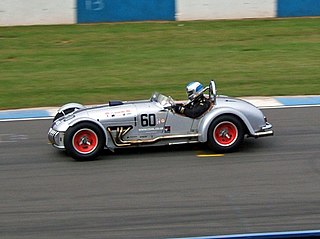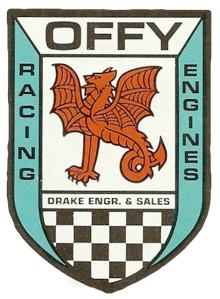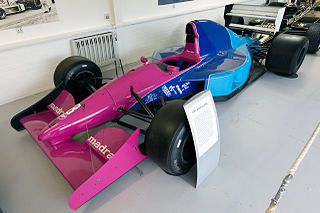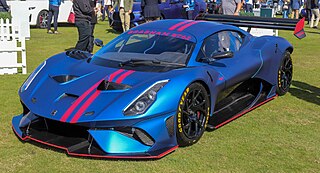Brabham is the common name for Motor Racing Developments Ltd., a British racing car manufacturer and Formula One racing team. Founded in 1960 by Australian driver Jack Brabham and British-Australian designer Ron Tauranac, the team won four Drivers' and two Constructors' World Championships in its 30-year Formula One history. Jack Brabham's 1966 FIA Drivers' Championship remains the only such achievement using a car bearing the driver's own name.

Sir John Arthur Brabham was an Australian racing driver who was Formula One World Champion in 1959, 1960, and 1966. He was a founder of the Brabham racing team and race car constructor that bore his name.

Ian Gordon Murray, is a South African-born British designer of Formula One racing cars and the McLaren F1 road car.

The 1966 French Grand Prix was a Formula One motor race held at Reims on 3 July 1966. It was race 3 of 9 in both the 1966 World Championship of Drivers and the 1966 International Cup for Formula One Manufacturers. The race was the "60th Anniversary race" of Grand Prix racing, which had started with the GP of France in 1906. It was also the 16th and last time the French Grand Prix was held on variations of French highways near Reims, following a three-year absence from the region. The race was held over 48 laps of the 8.35-kilometre (5.19 mi) circuit for a race distance of 400 kilometres (250 mi).

The 1966 Mexican Grand Prix was a Formula One motor race held at the Ciudad Deportiva Magdalena Mixhuca on 23 October 1966. It was race 9 of 9 in both the 1966 World Championship of Drivers and the 1966 International Cup for Formula One Manufacturers. The race was the fifth Mexican Grand Prix and the first to be run under the new three-litre Formula. It was held over 65 laps of the 5 km (3.1 mi) circuit for a race distance of 325 km (202 mi).

David Brabham is an Australian professional racing driver and one of the most successful and experienced specialists in sports car racing. He has won three international Sports Car series and is one of four Australians to have won the Le Mans 24 Hour sports car race, winning the event in 2009. Brabham won the American Le Mans Series in 2009 and 2010. He also competed in Formula One, racing for the Brabham and Simtek teams in 1990 and 1994, respectively. Brabham is the youngest son of three-time Formula One world champion Sir Jack Brabham, brother to Geoff Brabham and Gary Brabham. He is also brother-in-law to Mike Thackwell, father to Sam Brabham and uncle to Matthew Brabham.

Kurtis Kraft was an American designer and builder of race cars. The company built midget cars, quartermidgets, sports cars, sprint cars, Bonneville cars, and USAC Championship cars. It was founded by Frank Kurtis when he built his own midget car chassis in the late 1930s.

The Offenhauser Racing Engine, or Offy, is a racing engine design that dominated American open wheel racing for more than 50 years and is still popular among vintage sprint and midget car racers.

Silvio Moser was a racing driver from Switzerland.

The Brabham BT46 is a Formula One racing car designed by Gordon Murray for the Brabham team, owned by Bernie Ecclestone, for the 1978 Formula One season. The car featured several radical design elements, one of which was the use of flat panel heat exchangers on the bodywork of the car to replace conventional water and oil radiators. It was removed before the car's race debut, never to be seen again. The cars, however, powered by a flat-12 Alfa Romeo engine, raced competitively with modified nose-mounted radiators for most of the year, driven by Niki Lauda and John Watson, winning one race in this form and scoring sufficient points for the team to finish third in the constructors championship.

The Brabham BT49 is a Formula One racing car designed by South African Gordon Murray for the British Brabham team. The BT49 competed in the 1979 to 1982 Formula One World Championships and was used by Brazilian driver Nelson Piquet to win his first World Championship in 1981.

The Brabham BT19 is a Formula One racing car designed by Ron Tauranac for the British Brabham team. The BT19 competed in the 1966 and 1967 Formula One World Championships and was used by Australian driver Jack Brabham to win his third World Championship in 1966. The BT19, which Brabham referred to as his "Old Nail", was the first car bearing its driver's name to win a World Championship race.

The Benetton B186 is a Formula One racing car, built and raced by the Benetton team for the 1986 Formula One World Championship. It was the first car to be constructed and raced by Benetton, which had bought the Toleman team at the end of 1985 after several years of sponsoring it and other teams, including Alfa Romeo and Tyrrell.

The Brabham BT60 was the final series of Formula One racing cars built for the Brabham Formula One motor racing team. Designed by Sergio Rinland, they raced in the 1991 and 1992 Formula One World Championships. The car brought to a close Brabham's 30 years of construction of purpose-built racing cars, which began with Jack Brabham and Ron Tauranac and the Brabham BT1 Formula Junior design in 1961.

The Brabham BT3 is a Formula One racing car. It was the first Formula One design to be produced by Motor Racing Developments for the Brabham Racing Organisation, and debuted at the 1962 German Grand Prix. The Brabham BT3 was the vehicle with which team owner – then two-time World Champion – Jack Brabham, became the first driver ever to score World Championship points in a car bearing his own name, at the 1962 United States Grand Prix. The following year Brabham also became the first driver ever to win a Formula One race at the wheel of an eponymous car, again driving the BT3, at the 1963 Solitude Grand Prix. The BT3 design was modified only slightly to form the Tasman Series-specification Brabham BT4 cars.
The Brabham BT48 was a Formula One racing car designed by Gordon Murray and raced by the Brabham team. The car, powered by a 12-cylinder Alfa Romeo engine, competed in the 1979 Formula One season. The intended plan was to run the BT47 but the FIA outlawed it because it had a Chaparral 2J-type box rear end with twin variable geometry fans on the rear to maximize ground effect, so Murray designed the BT48 instead.

The Brabham BT62 is a mid-engine track day car produced by Australian car manufacturer Brabham Automotive. It was introduced in 2018 with deliveries expected to start at the end of that year. A planned production of only 70 cars is intended, in honour of the company's 70 year heritage in racing.

The Cooper T54 is a rear-engined open-wheel race car chassis, designed, developed, and built by Cooper, for U.S.A.C. Indy car racing, between 1961 and 1963. It was powered by a 250 hp (190 kW) 2.75 L (168 cu in) Coventry Climax FPF four-cylinder, but later used an Aston Martin six-cylinder engine, installed by automotive mechanic and engineer Joe Huffaker, after the car had been by Jim Kimberly to Kjell Qvale. After competing in IndyCar racing, it competed in a variety of different motorsports, including sprint car racing, where it was powered by larger Ford, Buick, and Chevrolet V8 engines.

The Brabham BT25 was an open-wheel racing car used in the 1968 and 1969 USAC Championships.
The Brabham BT32 was an open-wheel racing car, that competed in the USAC Championship Car racing, between 1970 and 1972 USAC Championships. In that time, it was driven by Jack Brabham, Bud Tingelstad, Johnny Rutherford, LeeRoy Yarbrough, and Swede Savage. It's best result in qualification was third-place, and its best race result was an 7th-place finish, being driven by Bud Tingelstad at the prestigious 1971 Indianapolis 500. It was powered by an 159 cu in (2.61 L) Offenhauser turbocharged four-cylinder engine, developing between 770–820 hp (570–610 kW).

















